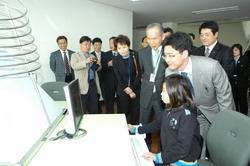U-school paves way for educational innovation
2006-06-01
1393 Views
- Contents
-
 As soon as students arrive at school, they put their student identification card on an electronic class board to register their attendance.
As soon as students arrive at school, they put their student identification card on an electronic class board to register their attendance.
Then, a parent receives a text message saying "Your child has just arrived at school at 8:35 a.m.," through their mobile phone every morning.
On the electronic message board, students' attendances are being checked and shown, along with the daily class schedules.
Not only student attendances but also other notices about homework and school materials are able to fall into the hands of parents through what is being termed "ubiquitous learning school" (u-school).
Under the so-called future-oriented educational infrastructure of "u-school," teachers give lectures to students by just clicking on electronic boards instead of writing on blackboards with a piece of chalk.
And such a school is not just fantasy, it is here and now.
The Busan Metropolitan City Office of Education launched the u-school in association with KT, the nation's largest fixed-line and broadband service provider, at Daesin Elementary School in the southern port city of Busan on May 2 on a two-year trail basis.
It is the first time in Korea for Internet-based, high-tech educational infrastructures to be operated all around a school.
"There are many schools adopting u-learning techniques initiated by the government. But this is the first time to introduce the Internet-based high-tech devices as an educational infrastructure to manage the whole educational system at school," Koh Yi-gi, a researcher with the Busan Education Research and Information Center, told Korea.net.
At the so-called "U-Daesin Elementary School," digital computer boards are installed in seven places such as arts and multimedia classrooms and the library, showing various materials carrying educational content.
Students can conduct various experiments through the computer boards and immediately confirm the results.
"It is very interesting to see what is wrong and right about a given question immediately through the computer board. It will be fun to study through the smart boards," Kim, an 11-year-old girl, said.
In addition to educational content, student health conditions are being checked and handled under the electronic system.
Children are encouraged to exercise in accordance with their electronically measured health condition.
A "mobile' class is also available for students in another class. If students take part in a field trip, other students in another class at the school can access the field trip content without going outside.
The school is equipped with closed circuit television (CCTV) in 16 places vulnerable to juvenile delinquency.
The school's administration office can watch what is going on through round-the-clock CCTV and control possible crimes.
"The concept of the u-school is different from the government-initiated u-learning or e-learning in many ways. The u-school means broader concepts by being equipped with digital-based infrastructures at schools as well as just teaching methods," Koh said.
"The u-school is offering a more comprehensive all-around educational environment including monitoring students' health conditions and crimes to provide more convenient educational atmospheres for students unlike the current u-learning which just indicates teaching and studying methods," Koh said.
He added the u-school will be operated for two years based on 11 items to measure the most educational and cost effective system to expand the program to other schools.
"The school is expected to raise educational effects and turn the school into a safe zone in which students can study and play through the electronic devices connecting parents to school," Kim Chul-soo, the school's principal, said.
However, the u-school has a long way to go due to high operation costs.
About 1.1 billion won has been spent setting up the system. Additionally, information usage fees are expected to cost hundreds of won per month.
"The u-school is being used in its initial period to measure educational efficacy and adaptability of technology into the educational field. After a two-year pilot program, the u-school will be expanded to elementary, middle and high schools," an education official said.
The Ministry of Education and Human Resources Development is trying to bring Internet-based and u-learning education within reach of primary and secondary schools.
The ministry last year designated about 18 elementary, middle and high schools nationally as pilot u-learning project schools.
IT-related corporations will provide the technological infrastructure, including 100 personal computers, 350 PDAs and 20 server systems valued at 1.3 billion won for homes and schools.
The chosen 18 schools will operate two systems; wireless learning and Internet-based learning.
Seven high schools will use PDAs as replacement tools for private tutoring and two elementary and middle schools will use PCs to test mobility, portability and adaptability to individual needs of the u-learning sector.
In the Internet-based sector, nine elementary and middle schools will implement cyber home schooling, connecting school education to home studies.
The ministry also operates cyber home schooling on websites in 16 cities and provincial education offices nationwide.
Under the government project, about 4,183 primary and middle school students have used 241 cyber classes for after school study since 2004.
The source of news : Korea.net May 31, 2006
